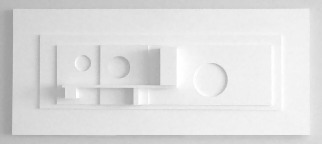terms // commissions // circle works // notes // contact
Graham Potter creates reliefs, constructions, paintings and prints using the Constructivist language of geometric and architectonic forms. These spare and largely monochrome works, informed by both land and marine architecture and pure geometry trace their origins back to the emerging modern movements in Europe during the early part of the 20th Century, particularly Suprematism in Russia and De Stijl (Neo Plasticism) in Holland.
Born in 1952 at Leigh-on-Sea, Essex the son of a fisherman and marine model maker, Graham Potter grew up surrounded by the paraphernalia of boats on the Thames estuary. After studying art he worked as an architectural assistant specialising in architectural interiors, joinery and shopfitting. He was elected to membership of the Chartered Society of Designers and set up his own practice during the 1980's.
|
Relief On A Seventh Module (1970 / 1997) |
In 1995 his desire for a more direct form of creative expression led to the creation of the first of the current group of reliefs. The following year a meeting with the Newlyn based artist John Wells (1907-2000) led to Graham Potter being invited by Wells and Henry Gilbert (of the Wills Lane Gallery St.Ives) to make a new enlarged version and edition of an earlier Wells relief, Relief on a Seventh Module 1970 (Homage to Ben and Gorin). |
|
Graham Potter also made a new version of the damaged Marine Construction 1941 for Wells. This piece and an example of the relief now reside in the John Piper art school at Epsom College where Wells studied.
Marine Construction (1941 / 1998) |
 |
The analytical approach fostered by his professional work and a close attention to detail are evident in all Graham Potter's reliefs and constructions. From pristine white surfaces and pure geometry to textures and forms that celebrate the shuttered concrete of Brutalist architecture. These mature and contemplative works achieve a monumental quality that belies their scale. The play of light across the relief surface changes their appearance through the day producing subtle differences in the shadows. The attention to detail extends to a flush wall hanging system for the heavier pieces.
Graham Potter continues to live and work overlooking the Thames Estuary at Chalkwell.
terms // commissions // circle works // notes // contact
